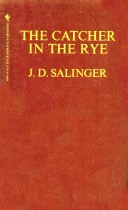 J.D. Salinger •
J.D. Salinger •
The Catcher in the Rye •
There isn’t much you can say about Catcher that hasn’t been said before. It took American literature in a whole new direction. It is J.D. Salinger’s masterpiece. It has fueled countless critical studies.
You should read it anyway, because the narrator, 16-year-old Holden Caulfield, has a gift for telling the truth. Everyone here is vividly real, from the professor in the ratty bathrobe who smells of Vicks Nose Drops to the girl who keeps all her kings in the back row when she plays checkers.
As the book opens, Holden is about to be expelled from yet another prep school. He doesn’t care; at Pencey Prep he’s “surrounded by phonies.” All that really matters to him is his kid sister, Phoebe—whom he loves so much he doesn’t even mind the drool on her pillow when she sleeps—and Ally, the younger brother who’s now dead. Holden keeps Ally’s baseball glove as a sort of talisman. Sometimes he prays to Ally.
Holden’s mishearing of a popular song gives the book its title. The only role he can picture himself playing in the world is that of catching younger kids who are “coming through the rye,” before the critical moment when they enter adulthood and turn phony.
Seventy years later, it may be hard to see why Catcher caused such a stir in 1951. There is no overt sex or gruesome violence. Holden’s mild profanity extends only to goddam and bastard—both of which pepper his speech at frequent intervals. What shocked people, I suspect, was the uncensored look inside a teenage boy’s head—equal parts confusion, resentment, bravado, wistfulness, desire, impatience.
You can read Catcher in an afternoon, but you’ll want to linger. And don’t imagine from its length that it’s unimportant. The Great Gatsby is pretty short too.






Your email address will not be published.